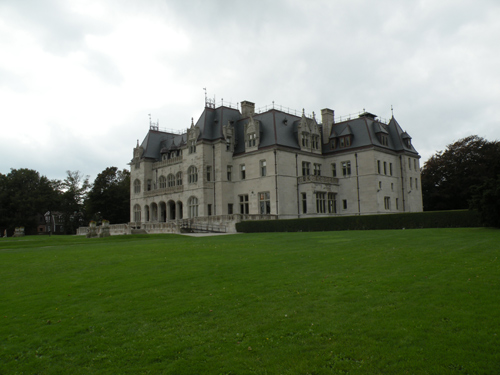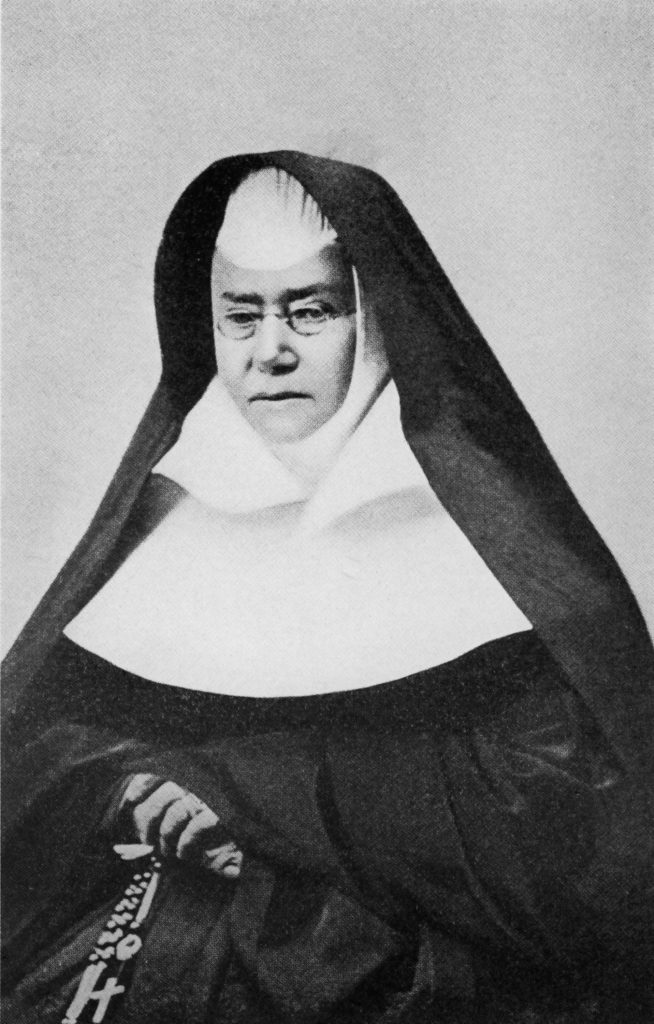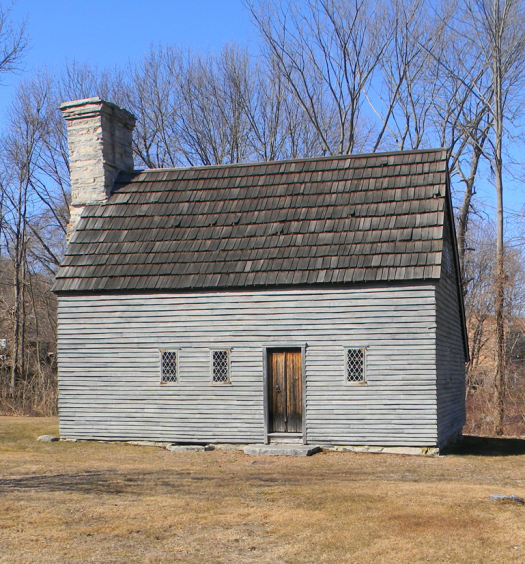Mary Francis Xavier Warde was the American foundress of the Sisters of Mercy (RSM). Born in Ireland in 1810 to fairly prosperous parents, she was orphaned in her teens. At age sixteen she moved to Dublin, where she met Catherine McAuley, a social service worker who established the Sisters of Mercy in 1831 to provide for the education and social needs of poor children, orphans, the sick, and homeless young women. Warde immediately joined the new order and became one of McAuley’s top assistants.
After establishing several convents in Ireland, Warde migrated to Pittsburgh in 1843. Her educational work on behalf of the Irish immigrants in that city prompted Irish-born Bishop Bernard O’Reilly to invite the Sisters of Mercy to Providence in 1851.
Bishop O’Reilly’s motives for inviting the sisters to his diocese were clear. Faced with a public school system with strong Protestant overtones, he sought an alternative that would provide a Catholic value-oriented education. In addition, he had a special desire to aid the orphans of the diocese who, through the untimely death of their parents or as a result of abandonment, were sometimes placed in Protestant homes. Therefore, the bishop hoped to establish a Catholic orphanage. For this dual purpose–education and social welfare–the Sisters of Mercy came to Rhode Island.
Mother Xavier Warde and four sisters arrived in Providence on the evening of March 11, 1851. Initially they lived in a small cottage on High (Westminster) Street. Then O’Reilly purchased the Stead estate at the corner of Providence’s Broad and Claverick Streets for them.
Within a year the Mercy community had expanded to thirteen. The sisters took over the schools at the Cathedral and St. Patrick’s in 1851 and those at St. Mary’s (Newport) and St. Joseph’s (Providence) in 1854. In addition, they assumed the care of nineteen female orphans in the frame house adjacent to their convent.
Catholic education, the principal function of the sisters, was also a prime concern of Bishop O’Reilly. Both he and Warde advocated a school in every Catholic parish. Under their direction, Catholic education made a formidable beginning in the years before the Civil War.
Mother Warde’s single most impressive legacy to Rhode Island was St. Xavier’s Academy, which opened in 1851. A boarding and day school combined, St. Xavier’s served as a novitiate for postulants and as a finishing school for girls of families with sufficient means. It was first housed in the convent on High Street, before moving in 1856 into a newly-built brick building on Claverick Street. In 1874 the boarding department was transferred to the newly-established St. Mary’s Academy, Bay View in East Providence. The Sisters of Mercy continue to sponsor St. Mary Academy – Bay View as a Catholic, all-girls Academy through grade twelve. The focus on single-sex education is rooted in the belief of Catherine McAuley that, “there is nothing more conducive to the good of society than the education of young women.”
Mother Warde’s Rhode Island apostolate was highly successful despite intense opposition from anti-Catholic nativists. In March 1855, at the height of the infamous Know-Nothing Movement, these zealots threatened to burn the Providence convent of “the female Jesuits” on Claverick Street for allegedly harboring a Protestant girl against her will. The mob was repulsed by Bishop O’Reilly, Irish defenders, and city authorities.
Warde served as superior of the Mercy order in Providence until 1858. After her departure, she continued her missionary work founding a total of twenty-seven convents in ten states. By the time of her death on September 17, 1884, at Manchester, New Hampshire, she had been responsible for bringing her new order of nuns to the service of thousands of Catholic immigrants from Maine to California.
In an age when most Americans, including females, believed that a woman’s place was only in the home, Catholic religious orders of women ran and taught schools, operated orphanages, administered and staffed hospitals, and ministered to the spiritual needs of their coreligionists. To most modern practitioners of so-called women’s studies, however, these nuns have remained historically cloistered. A recognition of the pioneering role in American life played by women like Mother Warde is long overdue.

Ochre Court, seen here from Cliff Walk, was built in 1892 as the summer home of New York financier Ogden Goelet. A descendant donated it to the Sisters of Mercy in 1947. It was the only building used by the college for several years.
The groundwork Mother Warde established for the Sisters of Mercy in Rhode Island eventually led to the order in 1934 obtaining a charter to establish what is now Salve Regina University in Newport. Originally a woman’s college, Salve Regina became coeducational in 1973, added university programs, and increased its enrollment to more than 2,700 students. Many of its spectacular university buildings are former Gilded Age mansions; some can be seen on Cliff Walk starting on Narragansett Avenue at the 40 Steps. The university proclaims on its website, “As Salve Regina grows, it remains firmly rooted in the heritage of its rich past. The vision which energized the Sisters of Mercy at the University’s founding remains the same today: Salve Regina, a Catholic university of distinction, will graduate men and women who positively impact the intellectual, spiritual and cultural life of their respective communities and work for a world that is harmonious, just and merciful.”
[Banner image: Mother Mary Xavier Ward (Salve Regina University)]


























